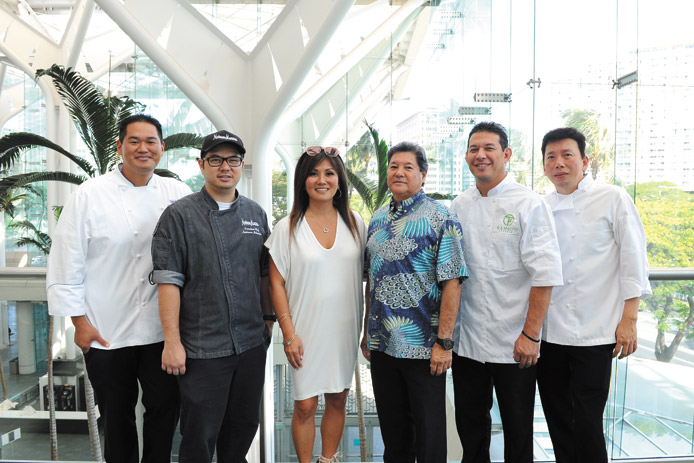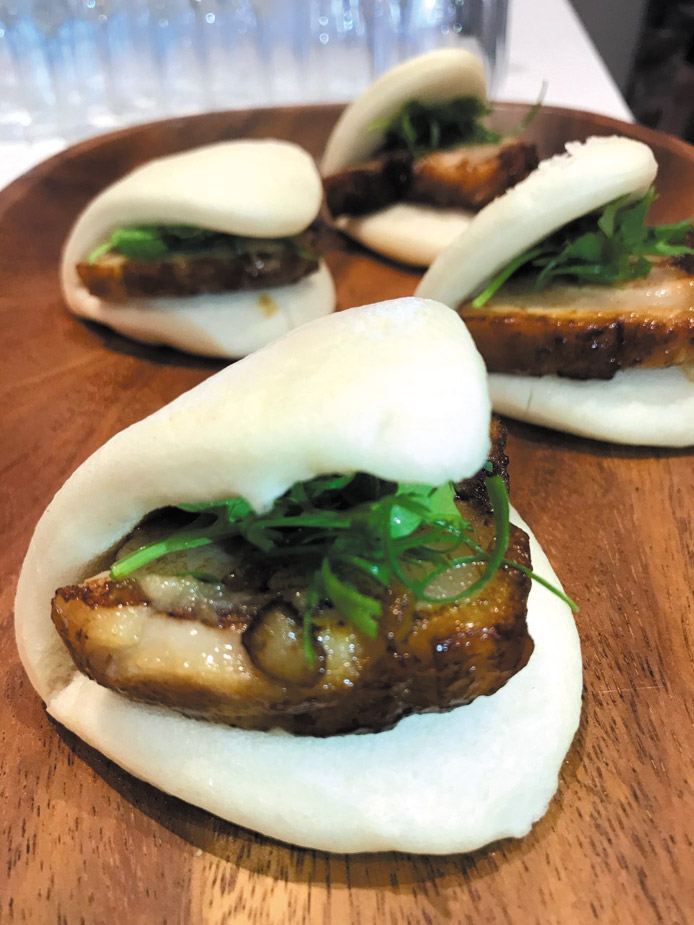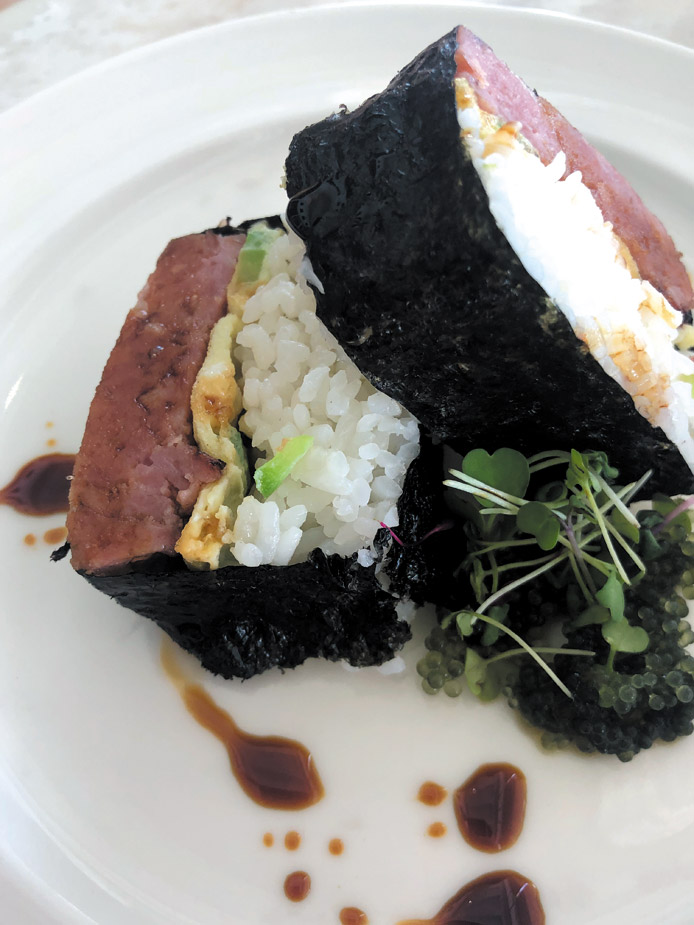
Chef Shaden Sato, left, Chef Lawrence Nakamoto, Anne Lee, Randy Kuba, Chef Jason Takemura and Chef Chai Chaowasaree gear up for Karii! An Awamori Experience at the Hawaii Convention Center.
ANNE LEE speaks with RANDY KUBA past president of Hawaiian Okinawan Association and creator of the Karii! An Awamori Experience kick off gala.
Ready those taste buds and get sippin’ and eatin’ at the upcoming Karii! An Awamori Experience that’s just around the corner, which will kick off the Okinawan Festival. On Friday, Aug. 30 from 6 to 9 p.m. Awamori aficionados and nonaficionados alike will flock to the convention center for an event embracing Okinawan culture. For more information or to purchase tickets visit the event’s website or send an email to Randy Kuba at randy@sharekuba.com.
Attendees will be able to try a plethora of cuisine made by 12 chefs from across the island who incorporate the alcoholic beverage Awamori in their cooking in addition to sipping on Awamori cocktails.
The drink is native to Okinawa, and dates back to the 15th century as a beverage reserved strictly for royalty. It is distilled from rice and has a 30-60 proof potency — 15-30 percent alcohol by volume. Its name pays homage to the bubbles (awa) that form during the distillation process (mori).
Before heading out to Karii! An Awamori Experience, here’s a little snippet of what event-goers can expect to tantalize their taste buds.
AL: What is this event about?
RK: Awamori is a basic commodity in the villages of Okinawa, what they do is bring people together in the villages. We wanted to bring that concept to Hawaii and share the culture. This Karii Awamori experience is a kick off for the actual Okinawan festival, and we want to share Awamori in the true spirit of the culture of Okinawa, in this kick off to the greater Honolulu community — the foodies, the business people, people outside of the Okinawan community. Okinawan people are very gracious and hospitable; I want to share that culture with the community. We want to invite the community to attend the kick off and then also attend the Okinawan Festival Saturday and Sunday.
For the Karii Awamori event on Friday, guests can purchase tickets by calling the Hawaiian Okinawan Center 676-5400. Tickets are $125 general admission, 21 and older. There are some corporate and platinum tables available, please call for more details. The maximum number of guests will be 500 and they are selling!
Chai Chaowasaree,
chef and owner of Chef Chai’s restaurant
My current restaurant has been at the Kapiolani location now for six years, but I have been in the restaurant industry for more than 30 years. My first restaurant was in Waikiki, called Singha, in 1988.
Bitter melon and pork are dishes that both Chinese and Okinawans love. Chinese and Okinawan cooking is a just a little different, where Chinese culture uses a lot of spices like cloves and cinnamon, Okinawan cooking is more shoyu and garlic based. We are going to do the Shoyu Awamori Braised Short Rib with Bao Bun and Pickled Cucumber. This meat is braised for four hours with the Awamori — slow cooked until its nice and tender and not falling apart.
Being in Hawaii is what creates our cuisine with the mixed culture of Japanese, Okinawan, Thai, Filipino, Korean and Vietnamese — Hawaii is an Asian melting pot, for sure. Being a part of creating a dish that has Okinawan influence, and using awamori, this is who we are; we do not want to make only one type of cuisine. My background is also Chinese cooking, we use a lot of pork, very similar to Okinawan. This is the first time that I am creating a dish. I have supported this event by attending in the past, which is what inspired me to be a part of this event and give back to this community. I am very happy to do so and look forward to the event.
PHOTO COURTESY CHAI CHAOWASAREE
Lawrence Nakamoto,
executive chef of Mariposa at Neiman Marcus
I have been with Mariposa for 6 years, and executive chef for 2 years. The dish for Karii! An Awamori Experience that I am preparing is our take on the Spam Musubi. We will make our homemade Spam Musubi with the Awamori, and incorporated that with a bitter melon omelet inside of the musubi and serve it with marinated sea grapes.
I am very familiar with Awamori, I am part Okinawan and I spent time in Okinawa, about three months there, and I drank it a lot. My sister’s husband is part of the Okinawan Festival Committee, so we partake in Awamori often. I wanted to be part of this event and give back to the Hawaii United Okinawa Association; my grandfather was from Okinawa and I’m happy to support my heritage.
PHOTO COURTESY LAWRENCE NAKAMOTO
Shaden Sato,
banquet and special events chef at the Halekulani Hotel
I have been at the Halekulani for 17 years. My dish that I am preparing is Awamori Braised Tako Salad Tostada with Shikuwasa Aioli and Avocado Mousse. This is a local fresh tako, that we braise in an Awamori konbu broth, after we make a salad, almost like a ceviche with it, for texture and rounding out the flavor we put it on a tostada with avocado mousse, for the Okinawan influence, we take the shikuwasa and make an aioli with it.
As a chef at the Halekulani, I was invited to be a part of this event. I am very familiar with Awamori and I have family who is Okinawan also. The taste of Awamori is very special, it’s made with long grain rice, comparable to shoju in Japan. It’s a very clean spirit, very delicious. At Halekulani, we did feature a cocktail making with Awamori that included three cocktails.
Jason Takemura,
executive chef and owner of Bamboo Catering
I am making a Smoked Shitomi Belly with a Warabi Salad, both the marinade for the smoked shitomi and the salad itself will include Awamori. I have tried Awamori, and the way I can explain the taste is that it’s similar to sake. But, it’s prepared like shoju — it’s distilled, made like vodka but with long grain rice, while sake is fermented. Ironically I first tried it with Randy Kuba, who is heading this event. Randy held some sake and awamori tastings at the Pagoda when I was the executive chef there.
A lot of the influence of the flavors that I use is from my grandmother, and both of my grandparents who worked in a plantation, she got a lot of influence and flavors from the Okinawan community there, which inspired some of my dishes. All of the special holidays and occasions, my grandmother would prepare the meals and she would prepare Warabi Salad — this is my take on that Okinawan experience.
PHOTO COURTESY JASON TAKEMURA
Roy Yamaguchi,
chef and founder of Roy’s
This is the first time we are participating in this Awamori tasting event. I’m familiar with Awamori because my mother is from Okinawa, I’ve been drinking Awamori for over 30 years so, I’m familiar with product itself. I wanted to participate in this event because we try to diversify ourselves and be involved in community activities. Furthermore, because I am half-Okinawan.
My dish that I’m serving at the event is a popular Okinawan dish: Rafute Style Certified Angus Beef Shortribs — we are using the Awamori spirit to perk up the traditional dish. We infuse the Awamori, and the meat is braised in this liquid, soy and mirin so the flavor of the broth permeates into the meat itself. We braise it until fork-tender and glaze it. It will be served with charred green onion and black garlic aioli on the bottom, with the braised short rib on top, and miso pickled red onion and tomato as garnish with a little bit of watermelon radish.
PHOTOS BY ANNE LEE
See more articles from: Hawaii Convention Center







